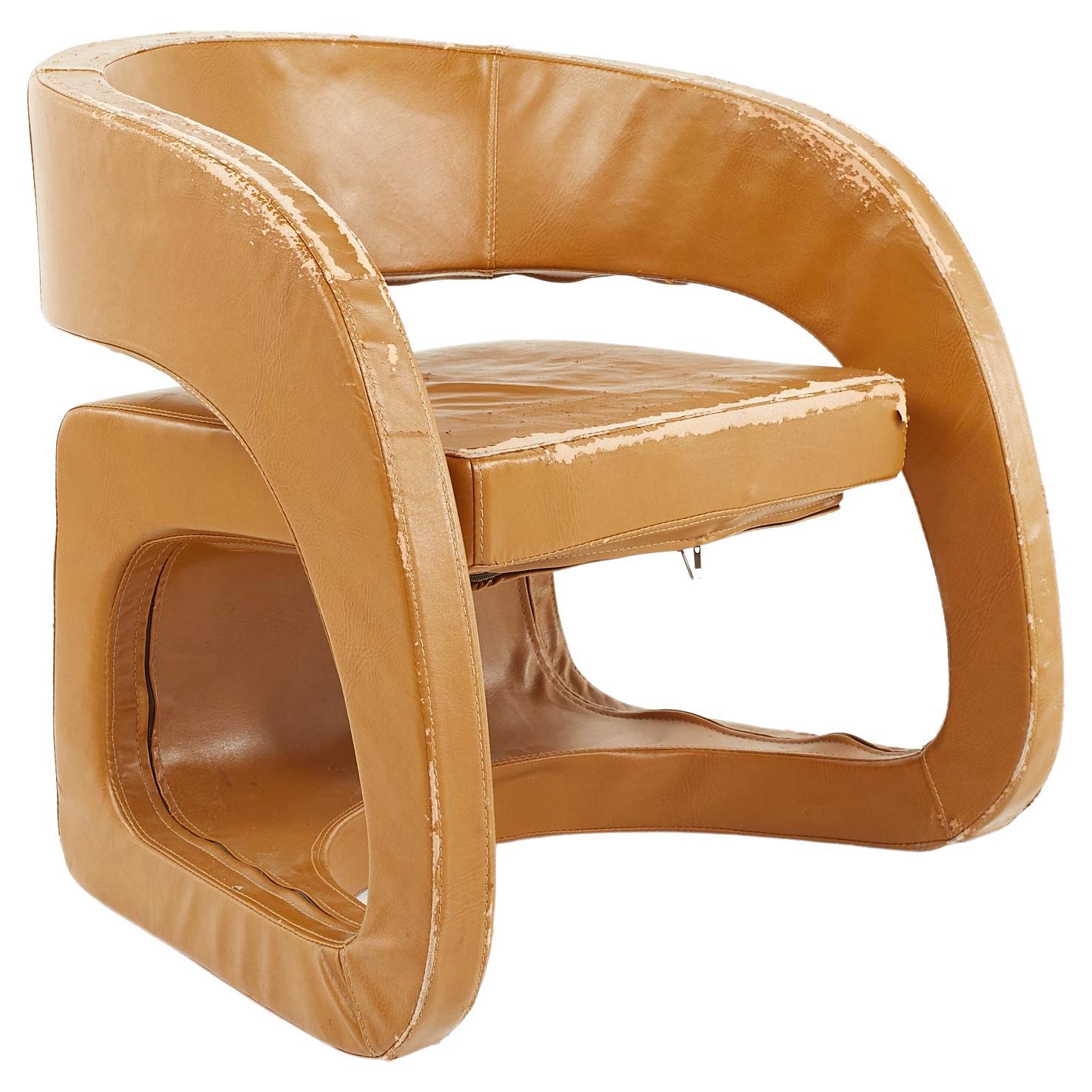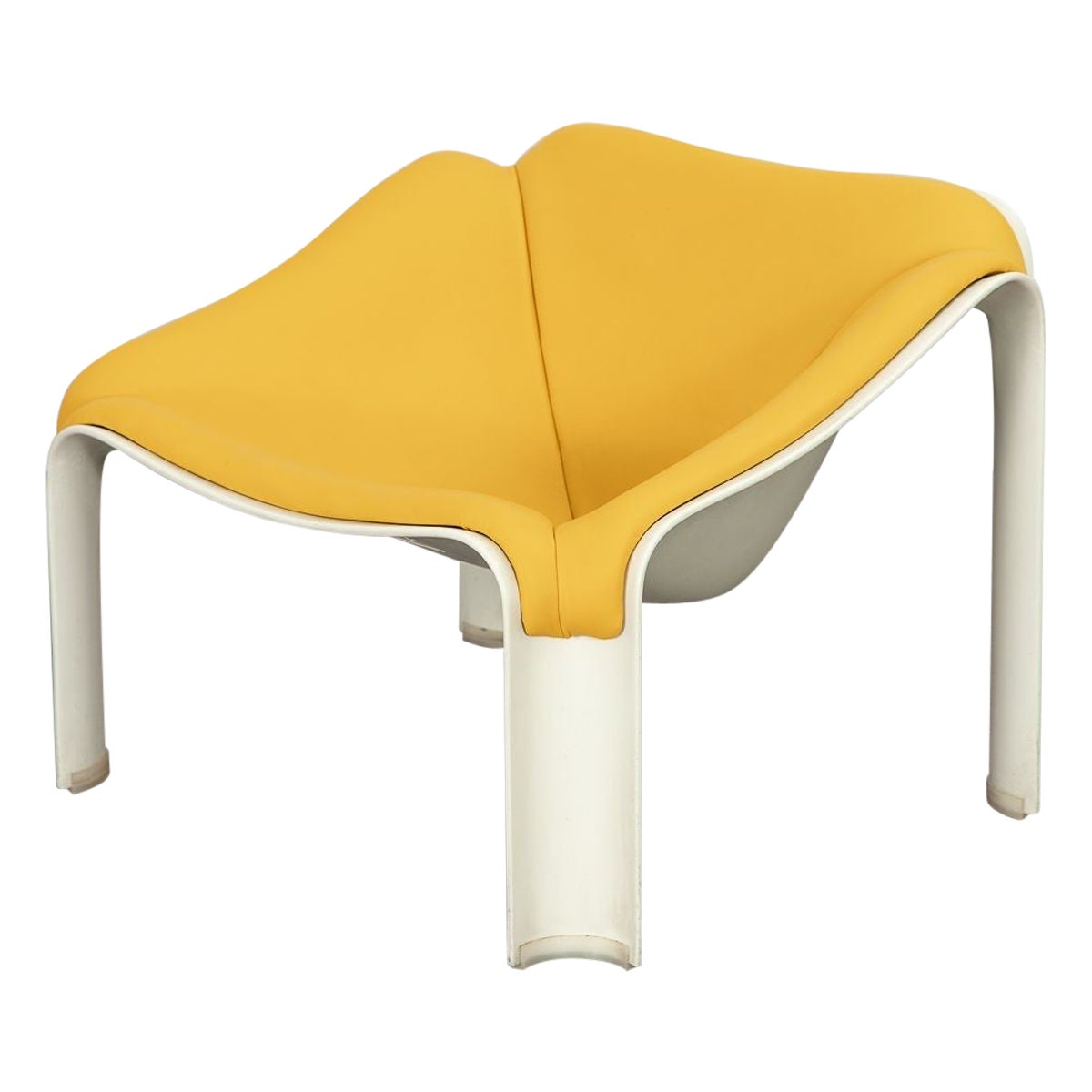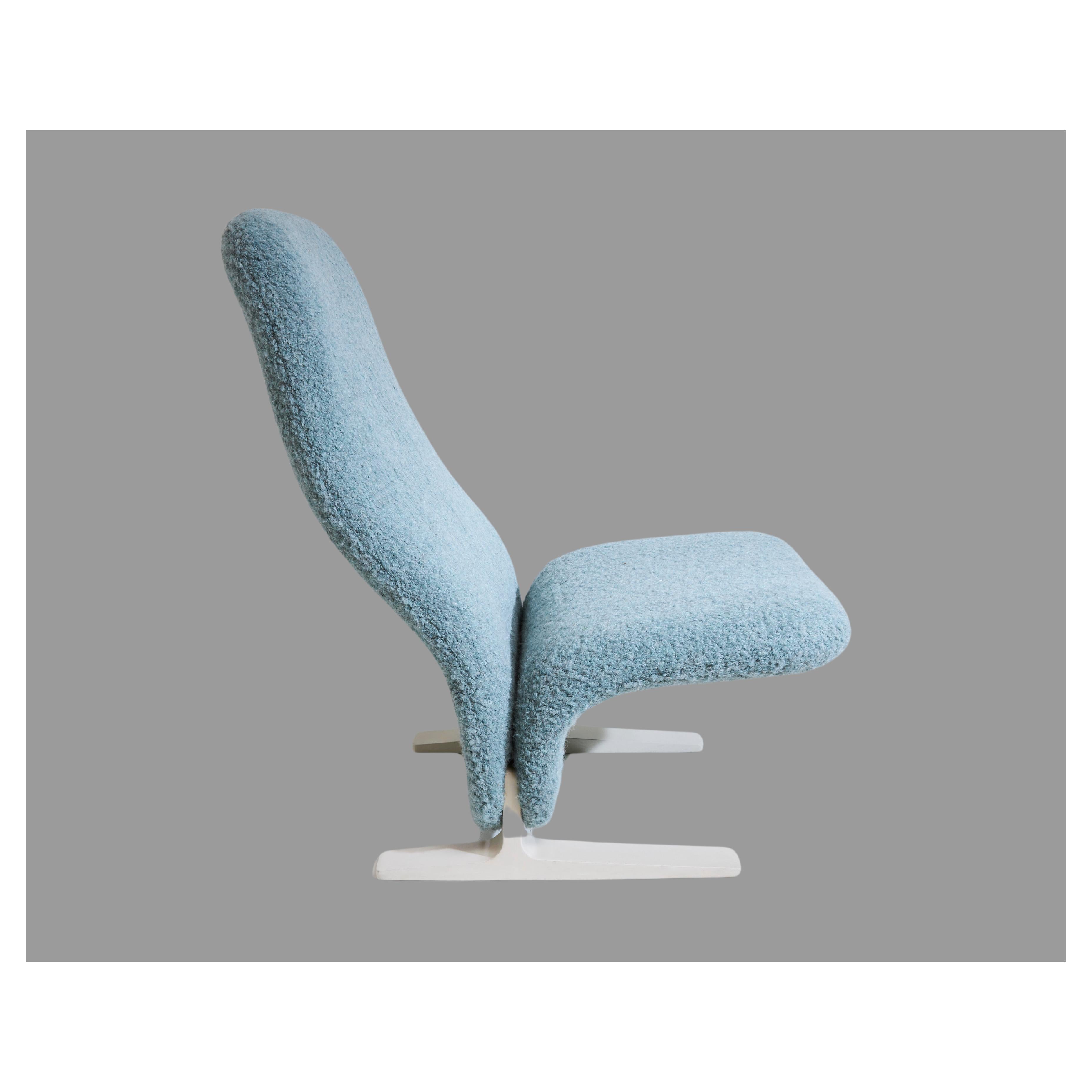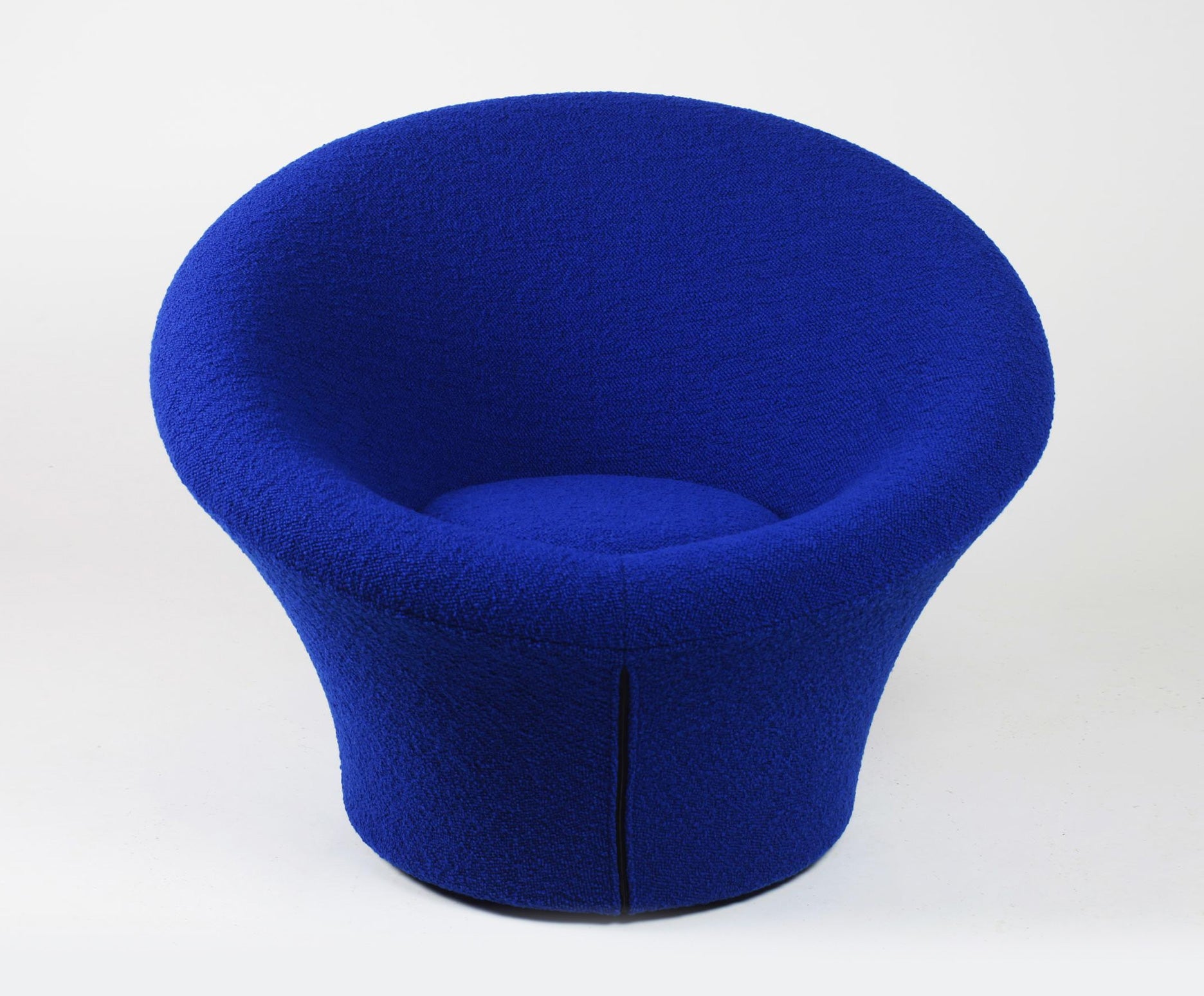Lounge chair f 560 Pierre Paulin mid century modern
About the Item
- Creator:Pierre Paulin (Designer)
- Design:
- Dimensions:Height: 23.63 in (60 cm)Diameter: 33.47 in (85 cm)Seat Height: 15.75 in (40 cm)
- Sold As:Set of 2
- Style:Mid-Century Modern (Of the Period)
- Materials and Techniques:
- Place of Origin:
- Period:
- Date of Manufacture:1959
- Condition:Reupholstered. Completely redone new foam and new fabric.
- Seller Location:Bruxelles, BE
- Reference Number:1stDibs: LU3232138895002
Mushroom Chair
Plush, sculptural and low to the ground, the Mushroom chair is seating that prioritizes comfort over formality. Designed in 1960 to envelop the body, it anticipated an audacious era of exploration and rampant challenges to conventionality, and with its bright-colored fabric and bold organic form, the Mushroom chair was an immediate hit upon its release. For French designer Pierre Paulin (1927–2009), who had been in search of new methods of manufacturing chairs when he conceived of this provocative piece, he’d come a long way.
Paulin initially pursued ceramics and then trained as a sculptor in Burgundy, but gave up the latter after he injured his arm during a fistfight. Instead, he attended the École Camondo in Paris. “To make drawings of Louis XVI chairs was a good education, like learning Latin,”' he later said of his time at the institution. Early-career modernist experiments saw Paulin working with bent plywood processes and covering chair frames with stretched womens’ swimwear pieces during his tenure at Thonet — endeavors that would preface his celebrated work at Dutch manufacturer Artifort in the years that followed.
The production behind the Mushroom chair was nothing short of revolutionary, even though it required minimal materials. Underneath its single-piece elastic stretch jersey cover, a frame of steel tubing covered with molded foam padding comprises the piece’s alluring shape. Paulin would continue to use this construction technique at Artifort throughout the decade, including in two of his memorable designs, the Ribbon chair (1966) and the Tongue chair (1967). Still manufactured by Artifort, the Mushroom chair is as striking and seductive as ever.
Pierre Paulin
Pierre Paulin introduced a fresh breeze into French furniture design in the 1960s and ’70s, fostering a sleek new space-age aesthetic. Along with Olivier Mourgue, Paulin developed furnishings with flowing lines and almost surreal naturalistic forms. And his work became such a byword for chic, forward-looking design and emerging technologies that two French presidents commissioned him to create environments in the Élysée Palace in Paris.
Paulin was born in Paris to a family of artists and designers. He initially sought to become a ceramist and sculptor and was studying in the town of Vallauris near the Côte d'Azur — a center for pottery making, where Pablo Picasso spent his postwar summers crafting ceramics — but broke his hand in a fight. He enrolled at the École Camondo, the Paris interior design school. There, Paulin was strongly influenced by the work of Charles and Ray Eames, George Nelson and Arne Jacobsen, as was reflected in his early creations for the manufacturer Thonet-France. It was at the Dutch firm Artifort, which he joined in 1958, where Paulin blossomed. In a few years, he produced several of his signature designs based on abstract organic shapes. These include the Butterfly chair (1963), which features a tubular steel frame and slung leather, and a group of striking seating pieces made with steel frames covered in polyurethane foam and tight jersey fabric: the Mushroom (1960), Ribbon (1966) and Tongue (1967) chairs.
In 1971, the Mobilier National — a department of France’s Ministry of Culture in charge of furnishing top-tier government offices and embassies — commissioned Paulin to redesign President Georges Pompidou’s private apartment in the Élysée Palace. In three years, Paulin transformed the staid rooms into futuristic environments with curved, fabric-clad walls and furnishings such as bookcases made from an arrangement of smoked-glass U shapes, flower-like pedestal chairs and pumpkin-esque loungers. Ten years later, the Mobilier National called on Paulin again, this time to furnish the private office of President François Mitterand. Paulin responded with an angular, postmodern take on neoclassical furniture, pieces that looked surprisingly at home in the paneled, Savonnerie-carpeted Louis XVI rooms. As those two Élysée Palace projects show, Paulin furniture works well both in a total decor or when used as a counterpoint to traditional pieces. You will see on 1stDibs that Pierre Paulin’s creations have a unique personality: bright and playful yet sophisticated and suave.
- ShippingRetrieving quote...Ships From: Bruxelles, Belgium
- Return PolicyThis item cannot be returned.
- Danish mid century lounge chair by Kurt ØstervigBy Kurt ØstervigLocated in Bruxelles, BELounge chair model 12 by Kurt Østervig for Schiller Postel Møbelfabrik. Reulphostered recently they are in pretty good shape. Possibility to have a pair of lounge chair .Category
Vintage 1960s Lounge Chairs
MaterialsFabric, Teak
- Crocus chair by Pierre Guariche for meuropBy Pierre GuaricheLocated in Bruxelles, BEcrocus chairs edited by Meurop in Belgium during the sixties and designed by Pierre Guariche. Completely reupholstered with quality fabric.Category
Vintage 1960s Belgian Mid-Century Modern Lounge Chairs
MaterialsAluminum
- Bamboo Swivel Lounge Chair 1970Located in Bruxelles, BEVery comfortable black swivel chair with cushions in light brown suede in good condition. There is a scratch in the black paint on the superior arc...Category
Late 20th Century Belgian Mid-Century Modern Lounge Chairs
MaterialsSuede, Rattan
- Pair of Osvaldo Borsani for Tecno P32 lounge chairBy Osvaldo BorsaniLocated in Bruxelles, BEPair of P32 designed by Osvaldo Borsani and edited by Tecno. Completely reupholstered with bouclette fabric with great craftsmanship the chair is comfortable and working properly as ...Category
Vintage 1960s Italian Mid-Century Modern Lounge Chairs
MaterialsMetal
- Wicker and metal Lounge Chair by Dirk Van Sliedrecht Mid modern centuryBy Dirk Van SliedregtLocated in Bruxelles, BEwicker lounge chair designed by the talented designer Dirk Van Sliedrecht: This remarkable wicker lounge chair transcends mere functionality—it embodies a harmonious blend of craftsm...Category
Vintage 1950s Dutch Mid-Century Modern Daybeds
MaterialsMetal
- Longwy Dishe Mid-Modern CenturyBy Faïenceries et Emaux de LongwyLocated in Bruxelles, BEBig dishes by Longwy with Medusa decor. Made in faience craquelée.Category
Vintage 1950s French Mid-Century Modern Platters and Serveware
MaterialsFaience
- Pierre Paulin Style Mid Century Upholstered Lounge ChairBy Pierre PaulinLocated in Countryside, ILPierre Paulin style mid century upholstered lounge chair The chair measures: 28.5 wide x 27 deep x 27.5 high, with a seat height of 17 inches and arm h...Category
Vintage 1970s American Mid-Century Modern Lounge Chairs
MaterialsUpholstery, Wood
- Pierre Paulin Leather Lounge ChairBy Pierre PaulinLocated in Los Angeles, CAPierre Paulin leather lounge chair, 444 model in original black leather with steel support and legs.Category
Vintage 1960s French Minimalist Lounge Chairs
MaterialsStainless Steel
- Mid-Century Tongue Lounge Chair by Pierre Paulin for Artifort, 1960sBy Artifort, Pierre PaulinLocated in Oud Beijerland, NLAmazing and very comfortable Tongue chair, designed by the French designer Pierre Paulin in the 60s and produced by Artifort. This lovely chair has the original high quality Kvad...Category
Vintage 1960s Dutch Mid-Century Modern Lounge Chairs
MaterialsFabric, Foam
- Pierre Paulin F300 Lounge ChairBy Artifort, Pierre PaulinLocated in Brooklyn, NYEarly production F300 lounge chair, designed by Pierre Paulin for Artifort. A striking space-age form, with appealing curving planes, constructed of molded fiber...Category
Mid-20th Century Dutch Lounge Chairs
MaterialsLeather, Fiberglass
- Concorde Lounge Chairs by Pierre PaulinBy Pierre PaulinLocated in Toronto, ONThe Concorde, an iconic lounge chair, was designed by French designer Pierre Paulin for the furniture manufacturer Artifort. Named after the French Concorde aircraft, which Paulin al...Category
Vintage 1960s Dutch Lounge Chairs
MaterialsWool, Bouclé
- Pierre Paulin for Artifort Oyster Chair Mid CenturyBy Artifort, Pierre PaulinLocated in Fort Lauderdale, FLPierre Paulin Oyster Chair. Rare model 156.Category
Vintage 1960s French Mid-Century Modern Lounge Chairs
MaterialsFabric
Recently Viewed
View AllRead More
Pierre Paulin Is Still Groovy after All These Years
A sprawling show at the Centre Pompidou in Paris spotlights the famed furniture designer’s oeuvre, including rooms for two French presidents.
At Château La Coste, Pierre Paulin’s Visionary Home Concept Finally Comes to Life
Now synonymous with 1960s and ’70s French chic, the designer conceived his modular modernist furnishings to change the way we decorate.







